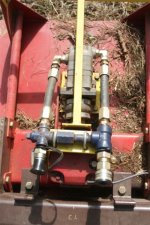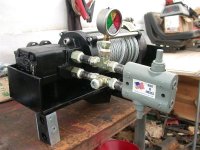woodlandfarms
Super Member
- Joined
- Jul 31, 2006
- Messages
- 6,118
- Location
- Los Angeles / SW Washington
- Tractor
- PowerTrac 1850, Kubota RTV x900
WOW, Guys... Thank you very much for all the info.
Akka, I am so glad you offered to drive down and help me with all my hydraulics project ;-)
JJ, Wayne, DFK As always, thank you very much.
My dream would be to do as JJ suggests, just replace the 3 spool system with a 4 spool system. I have two issues with this, the biggest being that I am pretty sure I do not have the room to cut a new hole for the additional controls given the limited real estate to the right of the steering wheel. Second is I have no clue what type of control would work there. I would assume that in this project the hoses I have would not be long enough and I would have to buy new hoses all around.
Also, none of the spools I see have the handles vertical. I am sure I am missing something here....
So I have 3 projects I plan to build this summer. The new grapple is for real, the post hole digger is a hope, and the stump grinder is a dream.
Akka, you said something that I need clarification on. Going to building a stump grinder or a post hole digger. These would be powered by my PTO circuit. (PTO's on PT tractors are located in the front and are hydraulic 18GPM at 3100PSI for my machine). In building the Post Hole digger, would I need to plumb some sort of "motor spool" bypass as the PTO is solenoid operated and the hoses really flex when you turn them on and off. I am thinking about motor shock. If so, what would that circuit look like.
Thanks again guys. I do love learning!
Carl
Akka, I am so glad you offered to drive down and help me with all my hydraulics project ;-)
JJ, Wayne, DFK As always, thank you very much.
My dream would be to do as JJ suggests, just replace the 3 spool system with a 4 spool system. I have two issues with this, the biggest being that I am pretty sure I do not have the room to cut a new hole for the additional controls given the limited real estate to the right of the steering wheel. Second is I have no clue what type of control would work there. I would assume that in this project the hoses I have would not be long enough and I would have to buy new hoses all around.
Also, none of the spools I see have the handles vertical. I am sure I am missing something here....
So I have 3 projects I plan to build this summer. The new grapple is for real, the post hole digger is a hope, and the stump grinder is a dream.
Akka, you said something that I need clarification on. Going to building a stump grinder or a post hole digger. These would be powered by my PTO circuit. (PTO's on PT tractors are located in the front and are hydraulic 18GPM at 3100PSI for my machine). In building the Post Hole digger, would I need to plumb some sort of "motor spool" bypass as the PTO is solenoid operated and the hoses really flex when you turn them on and off. I am thinking about motor shock. If so, what would that circuit look like.
Thanks again guys. I do love learning!
Carl




